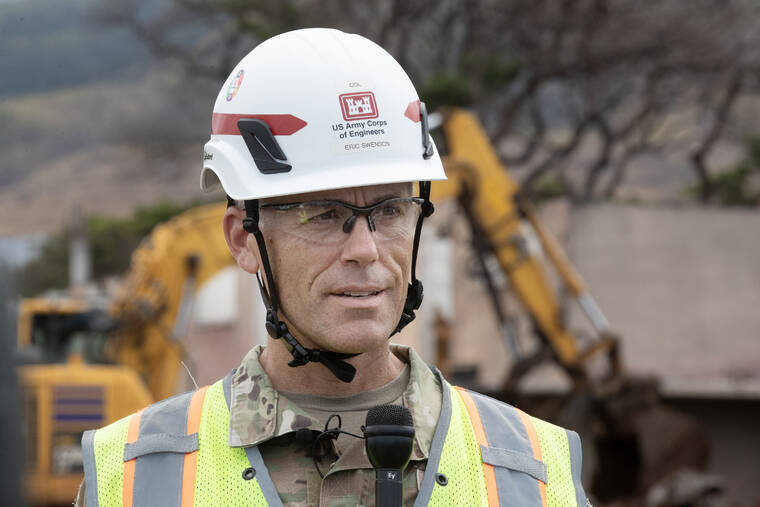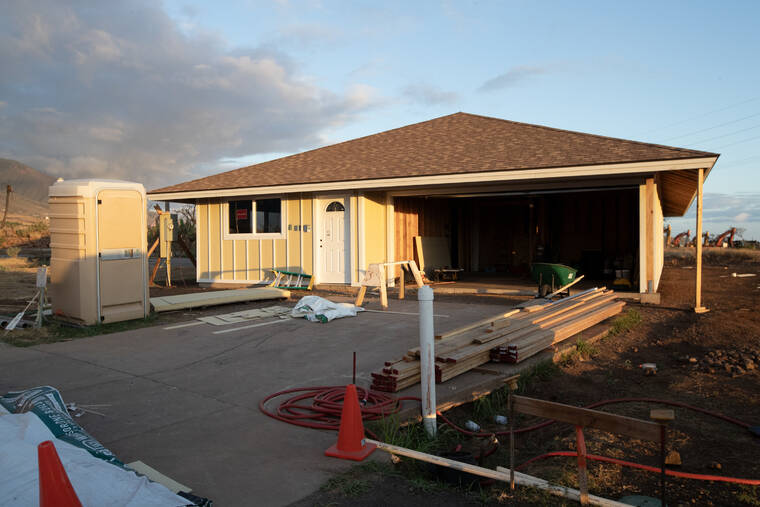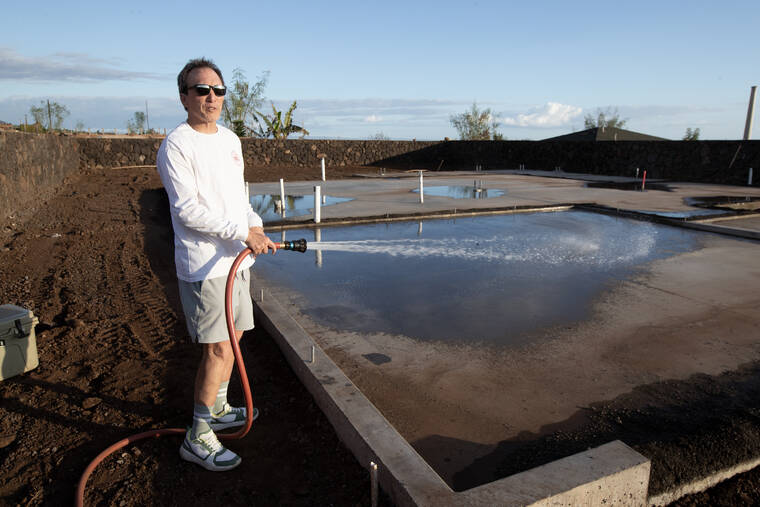Process of rebuilding begins in Lahaina

GEORGE F. LEE / GLEE@STARADVERTISER.COM
Debris removal by heavy equipment continued on Aug. 2 at the site of the Spinnaker Apartment building. Pictured is U.S. Army Corps of Engineers Col. Eric Swenson on hand for a press conference.

GEORGE F. LEE / GLEE@STARADVERTISER.COM
Rebuilt following the Aug. 8, 2023 wildfire, a home belonging to the Alexander family on Komo Mai Street in Lahaina appeared to be near completion.

GEORGE F. LEE / GLEE@STARADVERTISER.COM
Kari Alexander and her husband, Rich Alexander, stand in their home, which is being rebuilt, on Komo Mai Street in Lahaina.

GEORGE F. LEE / GLEE@STARADVERTISER.COM
Lahaina resident Kim Ball of Komo Mai Street waters down a concrete foundation to help it set. His foundation was one of the first to be poured in the neighborhood




LAHAINA >> Kari and Rich Alexander have a goal to celebrate this Christmas with their two children in a new home just like the one they lost in the Lahaina wildfire one year and four days ago.
The couple, who began rebuilding their three- bedroom house in June, likely will be the first property owner in the West Maui town to replace a residence destroyed by the inferno that claimed roughly 3,500 homes, more than 800 businesses and other structures including schools, churches and government buildings.
Several neighbors, meanwhile, aren’t far behind the Alexanders.
At least nine or so property owners on Komo Mai Street in a mauka section of Lahaina are in some stage of rebuilding — from ground compacting to framing.
Kim Ball, who along with the Alexanders was among about 60 property owners on Komo Mai Street whose homes burned down on Aug. 8, 2023, had his concrete foundation poured two weeks ago.
Ball said it’s awesome to see rebuilding up and down the street.
Don't miss out on what's happening!
Stay in touch with breaking news, as it happens, conveniently in your email inbox. It's FREE!
“We want to give people hope that we’re making progress,” said the 44-year Lahaina resident. “But also at the same time, there’s so much more to do. I mean it’s like — it’s going to be a long road still.”
Komo Mai Street property owners had an advantage because their subdivision, largely built by developers, is only several years old. So resubmitting previous building plans for permits saved time.
Overall, rebuilding in Lahaina is being challenged in many cases by daunting forces that include financial constraints of property owners and regulations governing special areas such as the town’s historic district and nearshore parcels.
By some estimates it could take five years or longer for some displaced homeowners to rebuild. Yet Komo Mai Street appears to be the leading edge of a building boom.
Beating expectations
Maui County officials said last week that 14 homes in Lahaina are under construction, along with two in Kula where an Upcountry fire destroyed 19 homes on the same day as the Lahaina fire.
The county also had issued building permits for 50 homes and was reviewing another 111 residential construction permit applications under an expedited process for fire survivors.
Maui Mayor Richard Bissen said in a statement that the county’s expectation a year ago was that it would be two to three years before any rebuilding started in Lahaina, and that efforts since then by federal agencies, county workers and private contractors have sped up results.
“The progress has happened more quickly than we initially thought,” Bissen said. “With each lot cleared and every new foundation continuing to be poured, a sense of hope is gaining momentum throughout Lahaina town.”
Jennifer Gray Thompson, founder and CEO of After the Fire USA, a nonprofit that has engaged in 18 wildfire disaster recovery efforts since 2017, said Maui’s pace of rebuilding is extraordinary.
Gray Thompson said having close to 20 homes under construction within a year of a megafire is unusual, and she’s not aware of any prior instance where rebuilding homes began before removing all disaster debris.
“You are definitely ahead of what we would have expected,” she said.
Elements aiding Lahaina’s rebuilding pace include knowledge gained from past megafires, extra contributions by federal agencies, a relatively compact burn area, incredible goodwill and strong community determination, according to Gray Thompson. She also said rebuilding in Lahaina had exceptional challenges, including near-shore proximity, cultural protection needs and many casualties. The fire killed 102 people.
Federal heft
The Federal Emergency Management Agency has been the financial backbone of recovery work, allocating more than $1.3 billion so far largely for the Environmental Protection Agency to clear hazardous materials from the burn zone, followed by U.S. Army Corps of Engineers work removing debris.
EPA also helped Maui County assess damage and make repairs to Lahaina’s water and wastewater infrastructure.
“The progress we’re making is unbelievable,” Shayne Agawa, director of the county Department of Environmental Management, said at a community recovery meeting in July. “We’re at this stage because of them (EPA).”
At that time, 63% of Lahaina’s sewer system had been made operational. Bissen said at the same meeting that the work EPA handled would have taken the county two years.
Lahaina’s potable water system was completely restored Aug. 2 after testing and fixes made with much help from EPA, an agency that has not typically done such work.
“This was a big event for Maui, for a small county, and knowing that they were overwhelmed, we want to provide them as much support as we can,” Bob Fenton, FEMA’s regional administrator heading up response work on Maui, said last week in an interview. “It’s really been a collective effort.”
As for debris removal, USACE, commanding a team of hired contractors, had as of about a week ago cleared all but 27 of 1,399 residential lots. Within about 90 days it expects to have the rest done, including very large parcels where apartment buildings once stood.
On Aug. 2, Col. Eric Swenson, USACE recovery field office commander on Maui, participated in a news media briefing in front of a former 57-unit condominium complex called The Spinnaker where two large excavators were clawing and scooping material on the site where only remnants of four two-story buildings remained.
As a debris hauling truck rolled by on Wainee Street, Swenson, dressed in camouflage fatigues, proclaimed, “That is the sound of progress here in Lahaina town.”
USACE also has removed about all of the roughly 3,500 destroyed vehicles from Lahaina, and cleared 69 of 159 commercial properties.
Swenson said that by February every last property should be cleared and certified as clean, which allows a property owner to apply for a building permit.
No commercial property owners had applied for a building permit as of last week, but one large rental apartment complex is under reconstruction.
Development firm Ikaika Ohana had opened Kaiaulu o Kupuohi, an 89-unit rental complex for low-income households, in December 2022. It burned down but is on pace to reopen by June, in part because the midrise building’s foundation wasn’t significantly damaged.
“We had 86 families that were displaced, and we’re anxious to get them back,” said Douglas Bigley, Ikaika Ohana president.
Of roughly 4,500 households displaced by the Lahaina fire, almost 90%, or about 3,900 households, were renters, according to Maui County. When they may be able to return to rebuilt homes is out of their control.
Permit process
To process building permits faster for destroyed properties, the county on April 29 opened a “recovery permit” office in Kahului run by contractor 4Leaf Inc.
County officials said permit review time would average 15 days for properties outside areas with special development rules.
Ball said he rejoiced upon hearing that his permit got issued May 22 after about 15 days.
“It was like, wow, it’s really happening,” recalled Ball, who is living with his wife and two dogs in a rented cottage in Launiupoko not far from Lahaina.
The Alexanders, whose house has a roof, windows and doors but still needs interior build-out, visited the recovery permit center on the day it opened after working on their application for all of April, and received their permit May 15.
Kari Alexander said she didn’t expect the county would deliver on its permitting timetable goal, but it did.
Many Lahaina property owners, however, face more difficulty with permitting.
For owners of property in the town’s historic district spanning several blocks, an environmental assessment is required if interior space of a home or homes on a parcel exceeds 3,500 square feet.
Owners of property in a much bigger area generally makai of Honoapiilani Highway, which is part of the state special management area under Hawaii coastal zoning law, could be subject to a more rigorous permitting process that can require a public hearing and Maui Planning Commission approval. However, exemptions are available for single-family homes under 7,500 square feet.
There is also a shoreline setback area where property owners must have the current shoreline certified and then follow the special management area process if the value of their project is over $500,000. Single-family homes used to be exempt from this regulation, but state lawmakers changed that in 2020.
To build in the shoreline setback area, which was recently updated to include 3.2 feet of potential future sea level rise, a property owner would need to obtain a variance from the Planning Commission.
Such obstacles, along with longer initial expectations for when rebuilding could begin, have contributed to some Lahaina property owners deciding not to return.
“We thought that this was going to be a three- to five-year process,” said Laurie Lei DeGama, who like Ball is a member of the county’s community advisory committee and lost her home in the fire. “That’s why people left, because we didn’t have a good idea how long this process was going to take.”
Ball said he knows more than one close neighbor who decided not to come back given so much early uncertainty over when they might able to rebuild.
“In some ways our street will never be the same,” he said. “Even though it will be rebuilt, it’ll never be the same.”
Ball and DeGama also say that they have great hope now for more people to rebuild sooner than once expected.
Pulling together
Bissen said at recent community meetings that the county is working to ease burdens of rebuilding in Lahaina in ways that include helping property owners finance construction and potential land swaps with owners in the shoreline setback area.
For instance, the county is funding grants up to $15,000 through the Council for Native Hawaiian Advancement for property owners to pay for pre-development costs for a primary residence that was destroyed or deemed uninhabitable from the wildfires.
Such grants can be used to cover things including design, engineering, permitting, site work and mortgage refinancing expenses for owner-occupants with household incomes no more than 150% of the county median.
Nonprofits, philanthropists and government agencies also are at work to help the community rebuild.
Through CNHA, several architectural firms are offering about 20 home design plans for free or reduced prices to property owners affected by the wildfires.
Three other nonprofits — Hawai‘i Community Lending, Hawai‘i Community Foundation and Holomua Collective — partnered in May to help up to 500 Lahaina property owners modify existing mortgages to prevent foreclosure and qualify for financing to rebuild their primary residence.
Financial help also has come from the U.S. Small Business Administration, which has approved more than $394 million in low- interest loans largely for owners of fire-damaged homes and businesses.
Property owners with fire losses even have an opportunity to obtain free fruit trees through Maui-based Treecovery Hawaii.
One big source of funding to rebuild is a $4 billion tentative settlement of an estimated 10,000 fire damage claims. If approved in state court, payments would be made over four years.
Funding to rebuild public facilities is coming from state, county and federal sources, including FEMA. So far, funding approvals under a FEMA program have included $10 million to rebuild Lahaina’s public library, $35 million to help rebuild two state affordable-housing projects in Lahaina and $45 million to reconstruct King Kamehameha III Elementary School.
Several historical buildings in Lahaina that weren’t totally destroyed are destined for restoration by the Lahaina Restoration Foundation, including the Baldwin Home Museum and possibly the Spring House, which date to when the town was the capital of the Hawaiian kingdom from 1820 to 1845. Other properties to be restored include the Old Lahaina Courthouse, Hale Aloha, U.S. Seamen’s Hospital and Old Lahaina Prison, according to the foundation.
On Tuesday, Pacific West Fuels reopened a fuel dock that cost more than $750,000 to rebuild at the state-owned Lahaina Small Boat Harbor to give boaters a place to refuel in West Maui. The harbor is undergoing other repairs that could take another two years or more to complete.
Gray Thompson of After the Fire USA said the collective effort in Lahaina is amazing, and she expects 99% of the town will be rebuilt within six years.
“I’m very optimistic, mostly because of the people,” she said.
Back on Komo Mai Street, the Alexanders visit to see the progress on their home every day, and they want others to know what is possible.
“It gives us hope that everybody can do it,” Kari Alexander said. “It really takes a village. It takes everybody.”



